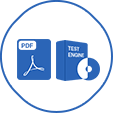Last Update 1 day ago Total Questions : 117
The MSP Foundation, 5th editionExam content is now fully updated, with all current exam questions added 1 day ago. Deciding to include MSP-Foundation practice exam questions in your study plan goes far beyond basic test preparation.
You'll find that our MSP-Foundation exam questions frequently feature detailed scenarios and practical problem-solving exercises that directly mirror industry challenges. Engaging with these MSP-Foundation sample sets allows you to effectively manage your time and pace yourself, giving you the ability to finish any MSP Foundation, 5th editionExam practice test comfortably within the allotted time.
Which section of the programme strategy defines the organization structure?
Which document identifies activities to give confidence to stakeholders about how programme risks are managed?
Which process ensures that the organization continues to focus on benefits once the work has been completed?
Which should the senior responsible owner focus on?
How does the ‘design’ theme apply the ‘lead with purpose’ principle?
Identify the missing word(s) in the following sentence:
Cash flow is the net amount of cash and cash-equivalents that the programme requires to pay for [?] over time.
Which is a result of the ‘structure’ theme applying the ‘collaborate across boundaries’ principle?

